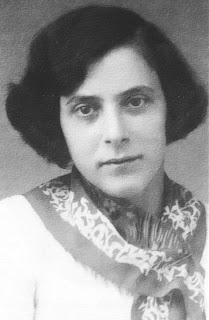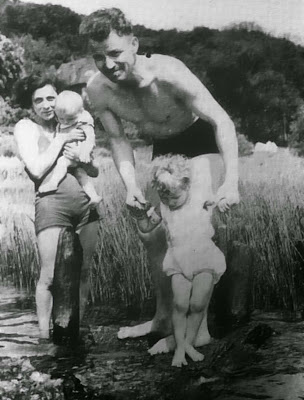August Landmesser
| Naissance | Moorrege |
|---|---|
| Décès | (à 34 ans) Ston |
| Nationalité | |
| Activité |
| Parti politique | allemands (- |
|---|---|
| Conflit | |
| Lieu de détention |
August Landmesser (né le , présumé tué à l'ennemi le , confirmé en 19491) était un ouvrier du chantier naval Blohm & Voss de Hambourg. Il est connu pour son apparition sur une photographie2 où il refuse d'effectuer le salut nazi lors du lancement d'un navire-école, le Horst Wessel, le 13 juin 19363.
Biographie
August Landmesser est le seul enfant d'August Franz Landmesser et de Wilhelmine Magdalene (née Schmidtpott). En 1931, espérant que cela l'aidera à obtenir un emploi, il rejoint le Parti nazi. En 1935, alors qu'il se fiance avec une femme juive née en 1913, Irma Eckler, il est exclu du parti4. La publication des bans en vue d'un mariage à Hambourg est refusée en application des lois de Nuremberg qui entrent en vigueur un mois plus tard. Ingrid, la première fille du couple, naît le 4.
La photographie célèbre, sur laquelle un homme identifié comme étant Landmesser refuse de faire le salut nazi, est prise le 5.
En 1937, August Landmesser tente de fuir au Danemark mais il est appréhendé et mis en prison. Un procès lui est intenté en raison de la seconde grossesse d'Irma, s'étant rendu coupable de « déshonorer la race » selon les lois raciales nazies. Au procès, August avance l'argument que ni lui ni sa femme ne savaient qu'Irma était « totalement juive », et il est acquitté le par manque de preuve, avec l'avertissement qu'en cas de récidive il aurait une peine de prison de plusieurs années. Alors qu'August et Irma continuent à vivre en couple, August est à nouveau arrêté le et condamné à deux ans et demi d'internement au camp de concentration de Börgermoor.
Quant à Irma Eckler, elle est détenue par la Gestapo à la prison de Fuhlsbüttel, où elle donne naissance à sa seconde fille, Irene5. Ingrid et Irene sont alors séparées. Placées initialement en orphelinat, Ingrid est confiée plus tard à sa grand-mère (puis à des parents adoptifs à la mort de la grand-mère en 1953) et Irene est placée chez des parents adoptifs.
Ensuite, Irma Eckler est envoyée au camp de concentration d'Oranienburg, au camp de concentration de Lichtenburg et enfin au camp de concentration pour femmes de Ravensbrück. Quelques lettres d'elle parviennent jusqu'en janvier 1942. On suppose qu'elle a été envoyée au centre d'euthanasie de Bernburg en février 1942, où elle fut tuée parmi les 14 000 victimes. En 1949, le tribunal d'instance de Hambourg-Altona la déclare décédée officiellement au .
August Landmesser est remis en liberté le 4 et embauché comme chef d'équipe dans l'entreprise de transport Püst, filiale de la société Heinkel-Werke à Warnemünde6. En février 1944, il est incorporé dans un bataillon disciplinaire, la 999e division légère Afrika où il est déclaré disparu en mission et présumé tué en Croatie le 1. En 1949, le tribunal d'instance de Rostock le déclare mort officiellement au 1.
Après la guerre
Le mariage d'August Landmesser et Irma Eckler a été reconnu rétroactivement par le Sénat de Hambourg à l'été 1951. L'automne de la même année, Ingrid a pris le nom de famille Landmesser. Irene a continué d'utiliser celui d'Eckler.
Postérité littéraire
- En 1996, Irene Eckler publie le livre Die Vormundschaftsakte 1935–1958: Verfolgung einer Familie wegen "Rassenschande"7. Le livre raconte l'histoire de sa famille, incluant de nombreux documents originaux (lettres de sa mère, documents officiels...)5.
- Une image, identifiée par Irene Eckler comme étant celle de son père, est publiée par Die Zeit le 22 mars 1991. Elle montre un grand rassemblement de travailleurs aux arsenaux navals de Blohm & Voss à Hambourg pour le lancement du Horst Wessel. Quasiment tout le monde sur la photo fait le salut nazi, à l'exception notable d'un homme vers l'arrière de la foule, qui reste ostensiblement les bras croisés sur sa poitrine. Une autre famille a identifié cet homme comme étant Gustav Wegert8,9.
- En 2018, Adeline Baldacchino lui consacre un roman, Celui qui disait non.
The photo was taken at the launch of a German army vessel in 1936, during a ceremony that was attended by Adolf Hitler himself. Within the picture a lone man stood with arms crossed as hundreds of men and women around him held up their arms in salute and allegiance to the Nazi Party and its leader, Adolph Hitler. Everyone in attendance is showing their undying support for Der Führer by throwing out their very best “Sieg Heil”.
August Landmesser, grimacing with arms crossed, stood strong and defiant as he showed his disapproval by not displaying support for the Nazi Party. What made this photo and Landmesser’s defiance unique is that it represented the protest of one man, in its most sincere and pure form. The source of Landmesser’s protest, like many great tragedies, starts with a love story.
The story of August Landmesser’s anti-gesture begins, ironically enough, with the Nazi Party. Believing that having the right connections would help land him a job in the pulseless economy, Landmesser joined the Nazi Party in 1931. Little did he know that his heart would soon ruin any progress that his superficial political affiliation might have made. In 1934, Landmesser met Irma Eckler, a Jewish woman, and the two fell deeply in love. Their engagement a year later got him expelled from the party, and their marriage application was denied under the newly enacted racial Nuremberg Laws.
August and Irma had a baby girl, Ingrid, in October of the same year, and two years later in 1937, the family made a failed attempt to flee to Denmark, where they were apprehended at the border. August was arrested and charged for “dishonoring the race” under Nazi racial law. He argued that neither he nor Eckler knew that she was fully Jewish, and was acquitted on 27 May 1938 for lack of evidence, with the warning that a repeat offense would result in a multi-year prison sentence.
The couple publicly continued their relationship and a month later August Landmesser would be arrested again and sentenced to hard labor for two years in a concentration camp. He would never see his beloved wife again. Eckler was detained by the Gestapo and held at the prison Fuhlsbüttel, where she gave birth to a second daughter Irene. Their children were initially taken to the city orphanage. Ingrid was later allowed to live with her maternal grandmother; Irene went to the home of foster parents in 1941.
Later, after her grandmother’s death in 1953, Ingrid was also placed with foster parents. A few letters came from Irma Eckler until January 1942. It is believed that she was taken to the so-called Bernburg Euthanasia Centre in February 1942, where she was among the 14,000 killed. In the course of post-war documentation, in 1949 she was pronounced legally dead.
August would be released in 1941 and began work as a foreman. Two years later, as the German army became increasingly mired by its desperate circumstances, Landmesser would be drafted into a penal infantry along with thousands of other men. He would go missing in Croatia where it is presumed he died, six months before Germany would officially surrender. His body was never recovered. Like Eckler, he was declared legally dead in 1949.

Believing that having the right connections would help land him a job in the pulseless economy, Landmesser joined the Nazi Party in 1931.









